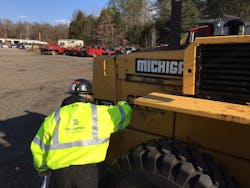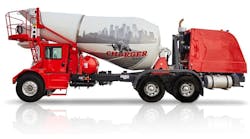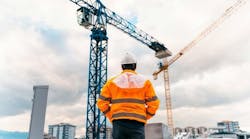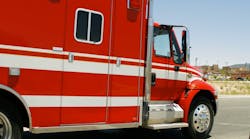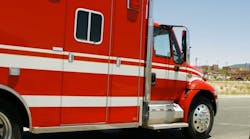“Every day, my goal is to ensure that people go home to their families,” says Brandon Batt, ASHM, STS, OSHP, site safety and health officer for Manhattan Construction Company in Arlington, Va.
“I’ve seen the opposite end, through my time in the military, and what physical injury and death can do to a family, especially when it’s a young person,” Batt, an 8-year U.S. Army veteran, says.
“It’s tragic. And in construction, with accidents and incidents, you can engineer the hazard out of things—you can make a job safe to where people can come to work and go home without issue,” he says.
Powerful words in a personal philosophy spoken with conviction by the 37-year-old.
Our fourth class of Under 40 in Construction Equipment winners was announced in 2016. These young people, all under the age of 40, represent exciting potential for the industry.
This is another in a series of profiles highlighting some of the winners. Our fifth class will be announced during Conexpo 2017. Click here to nominate an individual. The deadline is Feb. 15.
“It just takes an understanding,” Batt says, “of the human side of safety. On occasion, you have to step away from the books, or the thought process of ‘I have to check this box today and make sure this document is written correctly or my OSHA inspection isn’t going to go well.’
“You have to realize it’s all about the folks in the field, the people, and get into a mindset that this is a human life and it’s irreplaceable,” Batt says. “Whether it is a life that is injured or taken, it’s unacceptable in a professional environment.”
Batt implemented his philosophy on a very large scale during Manhattan’s recent building project for the U.S. Army, a six-story, 956,000-square-foot facility for the U.S. Army Medical Research Institute of Infectious Diseases in Fort Detrick, Md.
Part of his responsibility on that project was overseeing 4.75 million man-hours with a Lost Time Incident Rate of 0.28, compared to a national average of 1.50—that’s nearly five times better than the national average for nonresidential building construction.
“Safety comes with a buy-in,” Batt says. “One of our greatest successes was that we preached day in and day out to our subcontractors and our own employees that someone at home is waiting for you. That really started to hit home with our people when you reinforce the message in your orientation sessions, or when you stop somebody for a safety issue in the field.
“Achieving safety also takes management to buy in from the top down—it comes from them,” Batt says. “It’s their view, and they set forward a goal of zero, zero, zero [incidents and injuries]. Safety is often looked at as something written in a book, or that following procedures is how you keep people safe, but our viewpoint as a company is safety is important because you are talking about human lives.”
What also took hold among Manhattan employees and subcontractors was the way safety issues were addressed.
“Instead of barking an order or saying ‘The book says this,’ you handle it with a different approach and remind the person that they’ve got to think before they do the work, and think about safety not just because they’re going to get in trouble, but because somebody’s waiting for them at home,” Batt says.
Preparation also plays a large role in Manhattan’s safety work. “We put safety into planning on everything,” he says. “It’s the first stage to any work progress.”
Equipment assets receive the same “plan safety first” treatment.
“At the start of building projects, you have a heavy flow of dirt moving out, especially if you’re going down in the ground,” Batt says. “So you’ve got a lot of equipment working together in a small space, from cranes to dump trucks to excavators. From a safety standpoint, one key is making sure inspections are done.
“At Manhattan, we want to see [the evidence]. A lot of safety managers aren’t super stringent on morning inspections,” Batt says. “But our guys will go out into the field, fill out the paperwork, and show that they’ve inspected the stuff for the day. And we’ll follow up with random checks, making sure they followed the manufacturer’s specifications for inspecting equipment in the morning.”
When cranes arrive on the job site, Manhattan has a dedicated set-up process and requires a third-party inspection before work. There’s also an emphasis on training.
“It’s not one of those instances where ‘Hey, I’ve got a piece of equipment here, I’m going to hop on it and go to work,’” Batt says. “We make sure folks are trained. We want to see something from their company, or the state they’re in, that they’re able to operate that piece of equipment and all their licenses are up to date. That goes for cranes, especially. We require it.”
Batt also requires teamwork in the field, and he likes to lead by example.
“Let’s get out there and talk to people; let’s see how their morale is,” he says. “Let’s see what issues from yesterday are still impeding things today and knock those things out. Along with that is telling people, ‘I’m here for you; whatever I can do to help you out, I’m here to do that.’ It’s a paying it forward thing. If you put that attitude out there, you’re saying that the man next to them should get the same look.”
Batt reasons that if you treat one worker well and look out for him, that worker is going to treat the person next to him well, and so on. “Then you get a team in the field working well together and watching out for each other. It’s no longer the pipefitters doing their own thing and the electricians doing their own thing. It’s one team,” he says.
Batt is a big believer that empowerment must extend to every employee. “Listen to the guys in the field. It is imperative that every employee, that laborer who may be sweeping the floors, has a voice,” Batt says. “If you provide him with a voice, and you’re empowering him to stop work if he sees an unsafe act, you’re letting him know he’s not going to get in trouble or be called a snitch.
“If you don’t have the buy-in of every employee, and from the top of the chain of command, you don’t have anything,” Batt says. “The middle level only doesn’t work. Get with those folks at the worker level in the field and let them know their voice is being heard. I tell people on the job site that everyone is a safety manager. That’s how you build a safety culture. Even if you see something that you’re not sure if it’s by the book but it just looks unsafe, stop the work and ask the question.”
Batt is full of positive energy, but there is one thing he sometimes sees on a subcontractor level that gives him pause: those who embrace safety and talk a good game right up until it’s budget time.
“It’s the buy-in versus the money,” he explains. “A lot of companies have this great approach of ‘safety first,’ but we have a lot of over-OSHA requirements in the way we operate our job sites, and the first moment you tell them ‘We need you to have this,’ companies have said, ‘Wait a minute, that’s going to cost a lot of money for us all to get that.’ And then they want to take a second look at it and say it’s going to be an extra cost towards [Manhattan]. But you can’t put a number on safety. I think that’s where people can miss the point. It’s painful to watch,” Batt says.
“Safety is life. There’s no dollar sign you can put on life.”
